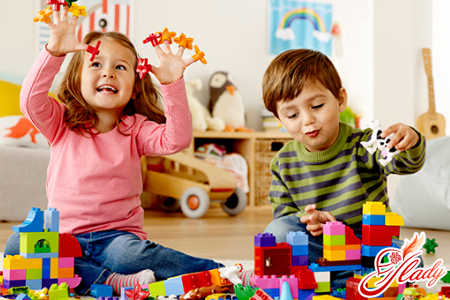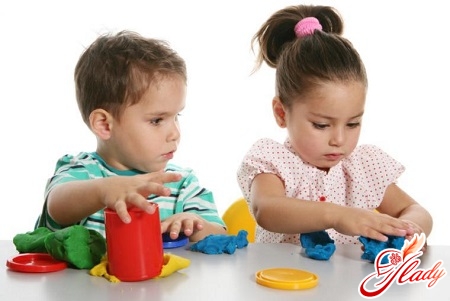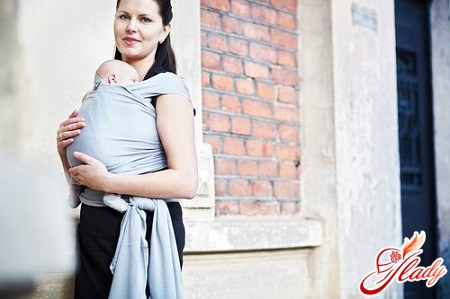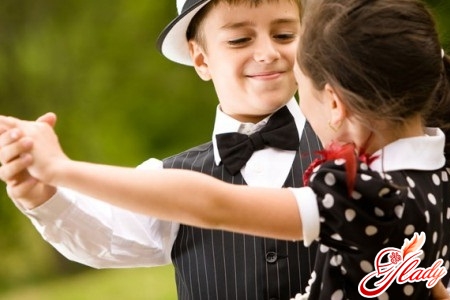 In the life of any parent, sooner or laterthere comes a time when you need to make a decision about where your child will study – in a sports section, a theater studio or an art school. Are you the parents of a wonderful boy, but a little shy and unsure of himself? Or is your child a girl who dreams of becoming a princess? In this case, you should consider such an option as sports ballroom dancing for children. Surely, everyone without exception has seen a performance of dancers at least once in their life. Agree that this is a very exciting spectacle – flexibility, plasticity, grace of partners cause sincere admiration. But all the stars of ballroom dancing began their path to the top of success at a young age, when a ballroom dancing school for children opened its doors to them. Sports ballroom dancing is ideal for young romantic individuals – after all, it wonderfully develops plasticity, teaches not only to hear music, but also to feel it. Many girls, having watched the performance of couples on TV, are completely delighted with the entourage surrounding ballroom dancing – music, swirling couples, beautiful dresses. Few girls can remain indifferent to this spectacle - that is why almost all of them visit ballroom dance studios with great pleasure. Boys are most often brought to ballroom dance studios by mothers who want to raise their sons to be real, well-rounded men. And this is quite true - not only are ballroom dancing classes for children a serious physical activity that will help a boy to stay in excellent shape, they also wonderfully socialize a person in the future. Believe me, a man who can dance well will feel comfortable in any company. Dance training also has the most beneficial effect on the general development of the child, being an excellent means of both physical and moral education. In addition, it wonderfully reveals the entire creative potential of the child. In addition, as already mentioned, ballroom dancing helps the physical development of the child - it trains and strengthens a variety of muscle groups, strengthens the cardiovascular and respiratory systems of the child's body. The child learns to perfectly control his body, use it to convey his feelings and emotions. In addition, ballroom dancing classes have a positive effect on the child’s emotional background and teach him to keep his emotions under control.
In the life of any parent, sooner or laterthere comes a time when you need to make a decision about where your child will study – in a sports section, a theater studio or an art school. Are you the parents of a wonderful boy, but a little shy and unsure of himself? Or is your child a girl who dreams of becoming a princess? In this case, you should consider such an option as sports ballroom dancing for children. Surely, everyone without exception has seen a performance of dancers at least once in their life. Agree that this is a very exciting spectacle – flexibility, plasticity, grace of partners cause sincere admiration. But all the stars of ballroom dancing began their path to the top of success at a young age, when a ballroom dancing school for children opened its doors to them. Sports ballroom dancing is ideal for young romantic individuals – after all, it wonderfully develops plasticity, teaches not only to hear music, but also to feel it. Many girls, having watched the performance of couples on TV, are completely delighted with the entourage surrounding ballroom dancing – music, swirling couples, beautiful dresses. Few girls can remain indifferent to this spectacle - that is why almost all of them visit ballroom dance studios with great pleasure. Boys are most often brought to ballroom dance studios by mothers who want to raise their sons to be real, well-rounded men. And this is quite true - not only are ballroom dancing classes for children a serious physical activity that will help a boy to stay in excellent shape, they also wonderfully socialize a person in the future. Believe me, a man who can dance well will feel comfortable in any company. Dance training also has the most beneficial effect on the general development of the child, being an excellent means of both physical and moral education. In addition, it wonderfully reveals the entire creative potential of the child. In addition, as already mentioned, ballroom dancing helps the physical development of the child - it trains and strengthens a variety of muscle groups, strengthens the cardiovascular and respiratory systems of the child's body. The child learns to perfectly control his body, use it to convey his feelings and emotions. In addition, ballroom dancing classes have a positive effect on the child’s emotional background and teach him to keep his emotions under control.
Ballroom dancing - to be or not to be?
Ballroom dancing is very, very beautiful.However, before rushing headlong to the nearest ballroom dancing studio, you need to decide for sure whether you are ready for your child to study there. So, what should you take into account? Ballroom dancing is a real art, but at the same time it is also a sport. Yes, ballroom dancing is recognized as an official sport, so dancers are not only artists, but also athletes at the same time. And children who do ballroom dancing develop not only creativity and artistry, but also agility and endurance. In addition, in ballroom dancing, as in any other sport, the spirit of competition is very strong. That is why it plays a rather serious role in the formation of the child's character, teaches him to be purposeful and hardworking, set goals and achieve them - in a word, helps the child grow up as a purposeful and strong personality. Since ballroom dancing is a real sport, like all its other types, it requires a rather serious approach. If you want your child to take up ballroom dancing professionally, be prepared for the fact that, as in any other sport, the price of success can only be frequent and long training and the most serious approach and attitude to the matter, both from the child and from the parents. Of course, before deciding to send your child to a ballroom dancing section, you need to know exactly what they are. So, ballroom dancing is divided into two programs:
In addition to these two directions, there is alsoSport rock-n-roll is a rather difficult and complex dance, a unique mixture of the most difficult sports exercises with elements of dance movements. In addition, there are also elements of folk ethnic dances.
Why is ballroom dancing a sport?
Not so long ago, ballroom dancing was considered onlyone of the directions in art, and nowadays it is recognized as an independent sport. Why did this happen? This fact can be explained very, very simply. Ballroom dancing classes require dancers to demonstrate exactly the same qualities that are inherent in real athletes: agility, endurance, determination, daily hard work, and the like. Below are the main criteria that allowed ballroom dancing to be recognized as an independent sport:
- Physical strength.
There are a huge number of ballroom dancinga variety of complex lifts, similar to those seen in figure skating. Incidentally, many of the basic lifts used in figure skating were borrowed from ballroom dancing. And to successfully perform them, remarkable physical strength is often needed.
- Flexibility of the body and coordination of movements.
In order to move freely on the parquet, do notWhen performing dance lines and figures, the partners must have well-developed coordination of movements and body flexibility. Incidentally, these qualities are necessary in most sports, not just ballroom dancing.
- Musical hearing and a sense of rhythm.
Since we are talking about dancing, it is quite natural that both partners should have an ear for music and a sense of tact. Otherwise, they will not be able to interact properly.
- Endurance.
Endurance is very important for dancers.And this is not surprising - all ballroom dancing competitions are held in several stages - from the qualifying round to the final round. And in each round, the performing couple must perform five dances, which last an average of two minutes each. Agree that it is not difficult to imagine the level of stress on the participants' bodies. But the life of dancers is not only performances, it is also regular grueling heavy training for many hours.
- Strict discipline and ability to work in a team.
Ballroom dancing, by the way, is a team sport.sport. Moreover, a team may consist of more than just two partners. The largest ballroom dancing team consists of 16 people, i.e. 8 couples. Judge for yourself what level of discipline the dancers must have in order to successfully interact with all team members at once.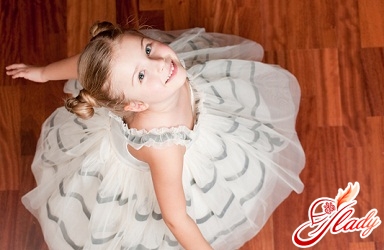
Clothes and shoes for ballroom dancing
Deciding to be or not to beballroom dancing in your child's life, you can't help but take into account such an aspect as the financial side of the issue. Ballroom dancing is one of the most expensive sports. And it's not even about the cost of ballroom dancing lessons, although it is not cheap either. However, the most expensive thing is ballroom dancing costumes for children. In addition to the fact that a child needs at least two training suits and a pair of training shoes, he also needs performance costumes. You can buy training suits in stores specializing in selling dance clothes. However, with performance costumes, things are a little more complicated - they have to be made to order. And this applies to both boys and girls. And the cost of such a costume can vary greatly - starting from several hundred dollars. And since our article is about children involved in ballroom dancing, we need to remind parents that a performance costume will last a maximum of one year. After all, children, unlike adults, grow very quickly, outgrowing expensive costumes. In addition to all the above nuances, you can't lose sight of such an expense item as travel to competitions. Not only will you have to pay the fees, you will also have to pay for travel to the competition venue, accommodation and food. And this is also a considerable amount. It is much wiser to assess the financial capabilities of the family in advance than to inform the child later that you have no money. Believe me, this will be a severe disappointment for him and a strong blow to the child's psyche.
At what age do you go out on the floor?
So, the decision has been made and ballroom dancing is still onbe. And here another question arises - at what age should a child be sent to a ballroom dancing studio? It is quite difficult to answer it unequivocally. On the one hand, in ballroom dancing, as in any other sport, in order to achieve results, it is necessary to bring a child at the most tender age. And on the other hand, it is quite difficult for children who have not reached at least five or six years of age to correctly perceive and evaluate the requirements of a coach. There are ballroom dancing studios that accept children from about three to four years old. However, before taking your baby there, realistically assess his strength. If the baby is not yet able to concentrate, coordinate movements and quickly gets tired, you should not rush things and send him to a ballroom dancing studio. However, if the child is developed enough to perceive the commands of the coach, has a good memory, the ability to coordinate his movements well and has an ear for music, you can try and send the baby to dance. However, experts still say that the optimal age to start ballroom dancing is six years old.
The principle of the coach with children
Of course, parents are interested to know what kind ofThis is how ballroom dancing studios work with children. So, your child has been accepted to a ballroom dancing studio – what next? As a rule, at the beginning of training, the trainer will hold a parent meeting, where parents will be told a list of what the child needs to buy for further training. During the first year of classes, children most often dance alone. Children are initiated into the basics of the secrets of dancing. At this stage of training, the trainer’s task is to teach children the basics of rhythm and choreography, as well as basic movements in ballroom dancing. The basics of the main dances are studied - Cha-cha-cha, Slow Waltz, Jive, Quick Step, as well as some auxiliary dances, such as Blues, Polka, Disco. In the second year of training, when children are 6 - 7 years old, the trainer puts the children in pairs. During training, children begin to learn to perform the same movements that they learned last year, but in pairs. It is in the second year of study that children begin to take part in their first ballroom dancing competitions.
Competition in ballroom dancing
In the second year of study, when the children are alreadyare paired and go to their first competition in life, they begin their performances in the category "Beginners". The judges of the competitions show a little more leniency to such children than to the other participants - after all, they are not only beginners on the dance floor, but also younger than everyone else. If the year has gone well, and the pair of young dancers has shown good results, they are assigned the dance class "E -4". In this class, children take part in competitions in four ballroom dances: Quick Step, Slow Waltz, Jive and Cha-cha-cha. Children's dance couples who have been assigned this class are already considered full-fledged athletes. They participate in various types of competitions, both in class and in open groups at children's ballroom dancing competitions, in the Children - 1 group. In the event that at least one of the dancers in the pair turns ten years old in the current year, the pair automatically gets into the next age group "Children - 2". In this group, the competitions are much more serious than for kids. Moreover, those couples who, by the time they move to the Children – 2 group, have reached class D, have a big advantage. This means that children dance not four, but eight dances at the competitions: 4 dances from the European program – Slow and Viennese Waltz, Tango, and Quick Step, and 4 dances from the Latin American program – Rumba and Jive, Cha-cha-cha, Samba. Children take part in ballroom dancing competitions in the Children – 2 class for only two years. As soon as one of the partners in the couple turns 12, the couple is automatically transferred to the Juniors – 1 dance group. In this age group, children dance ballroom dancing almost according to the adult dance program. And the judges' requirements for such couples are also very strict – as for adults. In addition, in this age group, the requirements for the appearance of dancers – their shoes, costumes and hairstyles – change radically. Of course, not all children who come to a ballroom dance studio will grow up to be Alexander Berezina or Victoria Rudkovskaya. However, in any case, ballroom dancing lessons for children will not be in vain. The elegance and grace of your son or daughter will allow them to always remain the center of attention! We recommend reading:






